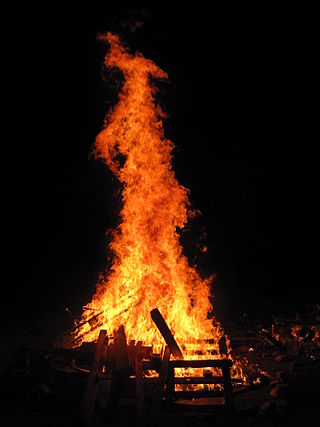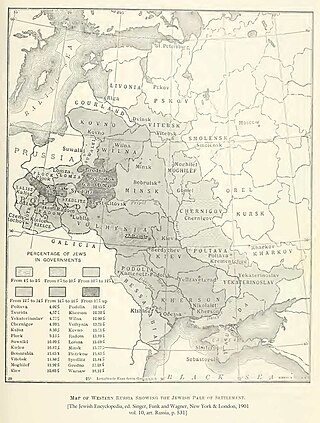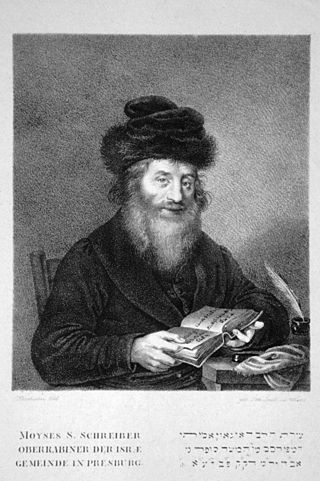
Chabad, also known as Lubavitch, Habad and Chabad-Lubavitch, is an Orthodox Jewish Hasidic dynasty. Chabad is one of the world's best-known Hasidic movements, particularly for its outreach activities. It is one of the largest Hasidic groups and Jewish religious organizations in the world. Unlike most Haredi groups, which are self-segregating, Chabad operates mainly in the wider world and caters to secularized Jews.

Yosef YitzchakSchneersohn was an Orthodox rabbi and the sixth Rebbe of the Chabad Lubavitch Hasidic movement. He is also known as the Frierdiker Rebbe, the Rebbe RaYYaTz, or the Rebbe Rayatz. After many years of fighting to keep Orthodox Judaism alive from within the Soviet Union, he was forced to leave; he continued to conduct the struggle from Latvia, and then Poland, and eventually the United States, where he spent the last ten years of his life.

Iyar is the eighth month of the civil year and the second month of the Jewish religious year on the Hebrew calendar. The name is Babylonian in origin. It is a month of 29 days. Iyar usually falls in April–May on the Gregorian calendar.

The Pale of Settlement was a western region of the Russian Empire with varying borders that existed from 1791 to 1917 in which permanent residency by Jews was allowed and beyond which Jewish residency, permanent or temporary, was mostly forbidden. Most Jews were still excluded from residency in a number of cities within the Pale as well. A few Jews were allowed to live outside the area, including those with university education, the ennobled, members of the most affluent of the merchant guilds and particular artisans, some military personnel and some services associated with them, including their families, and sometimes their servants. The archaic English term pale is derived from the Latin word palus, a stake, extended to mean the area enclosed by a fence or boundary.

Moses Schreiber (1762–1839), known to his own community and Jewish posterity in the Hebrew translation as Moshe Sofer, also known by his main work Chatam Sofer, Chasam Sofer, or Hatam Sofer, was one of the leading Orthodox rabbis of European Jewry in the first half of the nineteenth century.
The Union of Orthodox Rabbis of the United States and Canada (UOR), often called by its Hebrew name, Agudath Harabonim or (in Ashkenazi Hebrew) Agudas Harabonim ("union of rabbis"), was established in 1901 in the United States and is the oldest organization of Orthodox rabbis in the United States. It had been for many years the principal group for such rabbis, though in recent years it has lost much of its former membership and influence.

770 Eastern Parkway, also known as "770", is the street address of the World Headquarters of the Chabad-Lubavitch Hasidic movement, located on Eastern Parkway in the Crown Heights section of Brooklyn, New York, in the United States. The building is the center of the Chabad-Lubavitch world movement, and considered by many to be an iconic site in Judaism.

The history of the Jews in Prague is one of Central Europe's oldest and most well-known. Prague boasts one of Europe's oldest recorded Jewish communities, first mentioned by a Sephardi-Jewish traveller Ibrahim ibn Yaqub in 965. Since then, the community never ceased to exist, despite a number of pogroms and expulsions, the Holocaust, and subsequent antisemitic persecution by the Communist regime in the 20th century. Nowadays, the Jewish community of Prague numbers approximately 2,000 members. There are a number of synagogues of all Jewish denominations, a Chabad centre, an old age home, a kindergarten, Lauder Schools, Judaic Studies department at the Charles University, kosher restaurants and even a kosher hotel. Famous Jews from Prague include the Maharal, Franz Kafka, Miloš Forman and Madeleine Albright.

The history of the Jews in Latvia dates back to the first Jewish colony established in Piltene in 1571. Jews contributed to Latvia's development until the Northern War (1700–1721), which decimated Latvia's population. The Jewish community reestablished itself in the 18th century, mainly through an influx from Prussia, and came to play a principal role in the economic life of Latvia.

Ohr Avner Foundation is a philanthropic foundation that was established in 1992 by the Israeli billionaire and émigré from the former Soviet Union, Lev Leviev and is managed by its Director Rabbi David Mondshine. The foundation was named in memory of Lev Leviev's father Rabbi Avner Leviev. It supports a large network of Jewish educational institutions in the former Soviet Union, such as Jewish day schools, kindergartens and youth camps, a resource center and a teachers training institute.

Oholei Torah is the common name of the Lubavitch schools Educational Institute Oholei Menachem and Talmudical Seminary Oholei Torah. The main branches of the school and its administrative offices are located in Brooklyn, New York City.
The Novardok Yeshiva was one of the biggest and most important yeshivas in pre-World War II Europe, and a powerful force within the Mussar movement. It was the first of hundreds of a network of Musar yeshivas, which were created subsequently. They all assumed the name of Novardok yeshivas.

Chachmei Lublin Yeshiva was a Jewish educational institution (yeshiva) that operated in the city of Lublin, Poland from 1930 to 1939. At the time, it was one of the largest in the world.

The history of the Jews in Antwerp, a major city in the modern country of Belgium, goes back at least eight hundred years. Jewish life was first recorded in the city in the High Middle Ages. While the Jewish population grew and waned over the centuries, by the beginning of World War II Antwerp had a thriving Jewish community comprising some 35,000, with many Jews connected to the city's diamond industry. The Nazi occupation of Antwerp from 1940 and The Holocaust decimated the city’s Jewish population. By the time of Antwerp's liberation in September 1944, the Jewish population had fallen to around 1,200.

The Grand Choral Synagogue of Saint Petersburg is the third-largest synagogue in Europe. Other names include The Great Choral Synagogue of Saint Petersburg and The Edmond J Safra Grand Choral Synagogue. Sometimes it is simply referred to as the Saint Petersburg Synagogue or Bolshaya Sinagoga. It was built between 1880 and 1888, and consecrated in December 1893. The synagogue is located at 2 Lermontovskii Prospekt, Saint Petersburg, Russia. The Chief Rabbi of Saint Petersburg is Menachem Mendel Pewzner. Today the synagogue is a registered landmark and an architectural monument of federal importance.

Rabbi Shimon Lazaroff is the current Texas Regional Director for Texas Friends of Chabad Lubavitch, Inc. and member of the board and executive committee of Agudas Chasidei Chabad. With the direction of the Lubavitcher Rebbe, Rabbi Menachem Mendel Schneerson, he established Chabad Lubavitch in Texas upon his arrival with his family in 1972.

Australian Jews, or Jewish Australians, are Jews who are Australian citizens or permanent residents of Australia. In the 2016 census, there were 21,175 Australians who identified as Jewish by ancestry, a decrease from 25,716 in the 2011 census, and 91,016 Australians who identified as adherents of Judaism, which is a 6% decrease on 97,355 adherents of Judaism in the 2011 census. The actual number is almost certainly higher, because being a Jew is not just about being religious, but the census data is based on religious affiliation, so secular Jews often feel it would be inaccurate to answer with "Judaism". Also, since the question is optional, many practicing Holocaust survivors and Haredi Jews are believed to prefer not to disclose their religion in the census. By comparison, the Israeli newspaper Haaretz estimated a Jewish-Australian population of 120,000-150,000, while other estimates based on the death rate in the community estimate the size of the community as 250,000. Based on the census data, Jewish citizens make up about 0.4% of the Australian population. The Jewish community of Australia is composed mostly of Ashkenazi Jews, though there are Jews in Australia from many other traditions and levels of religious observance and participation in the Jewish community.

The first record of the Jewish community in Bratislava, capital of Slovakia, dates from 1251. Until the end of World War I, Bratislava was a multicultural city with a Hungarian and German majority and a Slovak and Jewish minority. In 1806 when the city was part of the Kingdom of Hungary, Rabbi Moses Sofer established the Pressburg Yeshiva and the city emerged as the center of Central European Jewry and a leading power in the opposition to the Reform movement in Judaism in Europe. Pressburg Yeshiva produced hundreds of future leaders of Austro-Hungarian Jewry who made major influence on the general traditional orthodox and future Charedi Judaism.

The Nizhny Novgorod Synagogue serves the Jewish community of the Russian city of Nizhny Novgorod, which currently numbers over 10,000 people. It is located at 5a Gruzinskaya Street.

This article presents the timeline of selected events concerning the history of the Jews in Lithuania and Belarus from the fourteenth century when the region was ruled by the Grand Duchy of Lithuania.
















